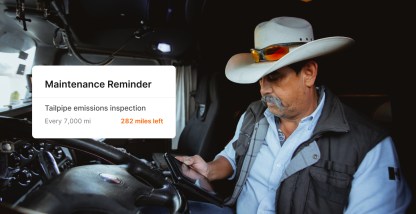The roadside inspectors stationed in Texas will give truck drivers the “benefit of the doubt” when it comes to verifying the authenticity of their electronic logging device (ELD) exemption claims.
They will do so during the months that would follow after the ELD rule’s implementation date.
The statement was made by Sergeant Dana Moore from the Texas Department of Public Safety (DPS) during a panel discussion that was held on August 24 at the Great American Trucking Show (GATS) 2017.
In this special GATS discussion, the panelists clarified some of the burning questions that members of the trucking industry had about the ELD mandate’s enforcement policies regarding roadside inspections.
They also explained some of the standard operating procedures that the Texas DPS officers and road inspectors plan to take during events and cases where truck drivers would claim that they are exempt from the ELD mandate.
The pre-2000 model year ELD exemption
The FMCSA recently updated its regulations regarding the pre-2000 vehicle ELD exemption.
Previously, vehicles with pre-2000 manufacturing dates were exempt from installing ELDs. The manufacturing date of the truck is determined based on its vehicle identification number (VIN), which is usually located in its chassis.
However, the FMCSA recently changed this basis of ELD exemption to vehicles that are equipped with pre-2000 model-year engines instead.
With this new update, verifying the model year of truck engines during roadside inspections could be problematic for safety officials.
According to Moore, engine plates are usually located “at the very bottom of the engine, under an inch of dirt and grease.”
Because of this difficulty and inability to properly inspect a vehicle, Moore said:
“The question is: Do we go forward and cite something or do we back off and check on it later?”
The benefit of the doubt
Sergeant Moore mentioned that safety officers would do all they can to identify an engine’s manufacture date during roadside inspections. Any vehicle that is found to be lacking in the compliance requirements of the ELD mandate could receive a 10-hour out-of-service order by safety officials.
In scenarios when officers would have a hard time determining the model year of a vehicle’s engine during roadside inspections, Moore said:
“We’re just going to accept [the driver’s’ word regarding the truck engine’s model year] at roadside unless we have some evidence to say otherwise.”
Additionally, Moore mentioned that safety officers who cannot determine an engine’s year model would instead file a request to the FMCSA asking its officers to follow up with them instead.
The FMCSA could then send inspectors and auditors to a motor carrier’s place of business in order to verify if the ELD exemption is really valid.
The ELD mandate requires motor carriers to keep any forms of documentation that verifies the model year of a vehicle’s engine in its principal place of business.
In the same way, if drivers claim that they are exempt from the ELD mandate due to them operating for not more than eight days per 30-day period, inspectors will do their best to verify the claims during inspections.
If these claims could still not be determined, inspectors would most likely give operators a pass and then file a request to the FMCSA for a follow-up.
According to Moore:
“There’s so much at a roadside inspection that we won’t be able to determine.…If we do suspect a driver is not using an ELD, we’re going to submit that.…[This would cause]auditors to come out and start checking records.”
ELD malfunctions
In a separate panel discussion that happened during the GATS event, a transportation specialist from the FMCSA’s enforcement division, LaTonya Mimms, explained to truck drivers how to respond in the case of ELD malfunctions.
Operators are required to notify their respective carriers of any ELD failure or malfunction within 24 hours.
These carriers will then be given eight days to either replace or repair the ELD unit.
Drivers are required to reconstruct the previous seven days of their Hours of Service (HOS) duty records on a paper log.
In her own words, Mimms said:
“They must continue to manually prepare records of duty status on paper logs until the malfunction has been corrected.”
The ELD mandate requires truck drivers to keep with them a blank supply of paper logs and other paper-supporting documents. These supporting documents include dispatch records, receipts for food and meals, bills of lading, and other types of documents that aid inspectors in verifying HOS compliance.
Carriers are required to retain up to eight supporting documents for every 24-hour period that a driver is on duty. Drivers are also required to file their logs and other supporting documents to their carriers within 13 days.
In addition, Mimms also talked about what operators are expected to do in the event ELDs continue to function in recording duty status but fails to transfer HOS data to roadside inspectors.
These devices should at least be able to either print the logs on paper or show to the roadside inspector its current logs via a display screen.
According to Mimms:
“It doesn’t have to do both, just one or the other.”
Next steps for ELD compliance
With only three months left before the ELD mandate compliance date, Mimms recommended during the panel discussion that carriers should start equipping their fleets with ELDs.
She mentioned how drivers should begin using ELDs in their daily routines as soon as they can, so they could “get comfortable with the device.”
If your fleet’s drivers are still using paper logs to comply with HOS regulations, allow us to help you with your transition towards complying with the ELD mandate. You can start implementing e-logs by asking your drivers to download the Motive free driving logs app. The #1 rated Motive elog app is available for iOS and Android devices.
If you have questions regarding Motive ELDs, contact us today. Call us at 855-434-3564 or connect with a sales rep.







